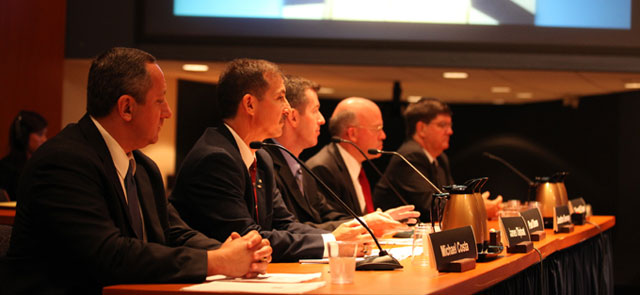
From left, panelists Michael Costa of the FAA Wings program, Air Safety Institute Director of Education Paul Deres, James Oliphant of the AOPA Insurance Agency, AVEMCO Insurance President Jonathan Greenway, and Thomas Turner of the American Bonanza Society address the NTSB June 19. Photo courtesy NTSB.
Free recurrent training programs available in person and online have positive effects on flight safety, but many general aviation pilots still pass up the opportunity. As the NTSB began a two-day forum focused on GA safety, experts agreed that participation in ongoing training and education is critical to improving safety.
Since 1950 the GA accident rate has decreased by 90 percent, in no small part due to the free safety education provided by the Air Safety Institute, which has invested more than $30 million in its safety programs over the last decade. Pilot participation in the institute’s safety programs is nearing two million each year—clearly leading the industry. However, AOPA Foundation Director of Education Paul Deres estimates that about two-thirds of AOPA members involved in an accident have never taken advantage of the Air Safety Institute’s safety programs, even though all are free and most are available online.
Deres said the rate of fatal accidents has remained nearly unchanged in recent years, and the primary causes also remain the same: poor airmanship and decision making. Errors in maneuvering flight, takeoff and landing mistakes, fuel mismanagement, improper IFR procedures, and encounters with adverse weather have long been recognized as leading culprits. While many pilots take advantage of Air Safety Institute programs—including free seminars, Real Pilot Stories, Accident Case Studies, and interactive courses—convincing the rest of the pilot population that a little refresher is a good idea remains a challenge.
“Some just seem to be unreachable,” Deres said. “And while it’s important to make every effort to get through to them, we should also continue educating those who are already looking for more ways to improve their knowledge and skills.”
The NTSB assembled panels of experts from AOPA and other organizations to discuss priorities, training, weather, technology, aircraft design, and maintenance.
“This is personal for us,” NTSB Chairman Deborah A.P. Hersman said, noting Dr. James “Mike” Duncan, NTSB Chief Medical Officer, lost his own life in a midair collision on Memorial Day. “Many on our staff, as well as many of our board members, are pilots.”
Hersman said that after years with little progress on GA safety, “the status quo is not acceptable. We need to break through the plateau and bring the accident rate down significantly.”
Deres said pilots may be reluctant to confront fellow aviators whose behavior is obviously unsafe, and the strategy to change the GA safety culture is not limited to an online approach.
“We can also get down to the community level and have a friendly, courteous talk to these pilots face-to-face,” Deres said. “We have some work to do, as individuals, to help improve GA safety.”
Air Safety Institute Chief Flight Instructor Kristine Hartzell joined another panel of industry experts to discuss aircraft design and certification issues June 20. The live webcast was to be recorded for viewing at a later date.


